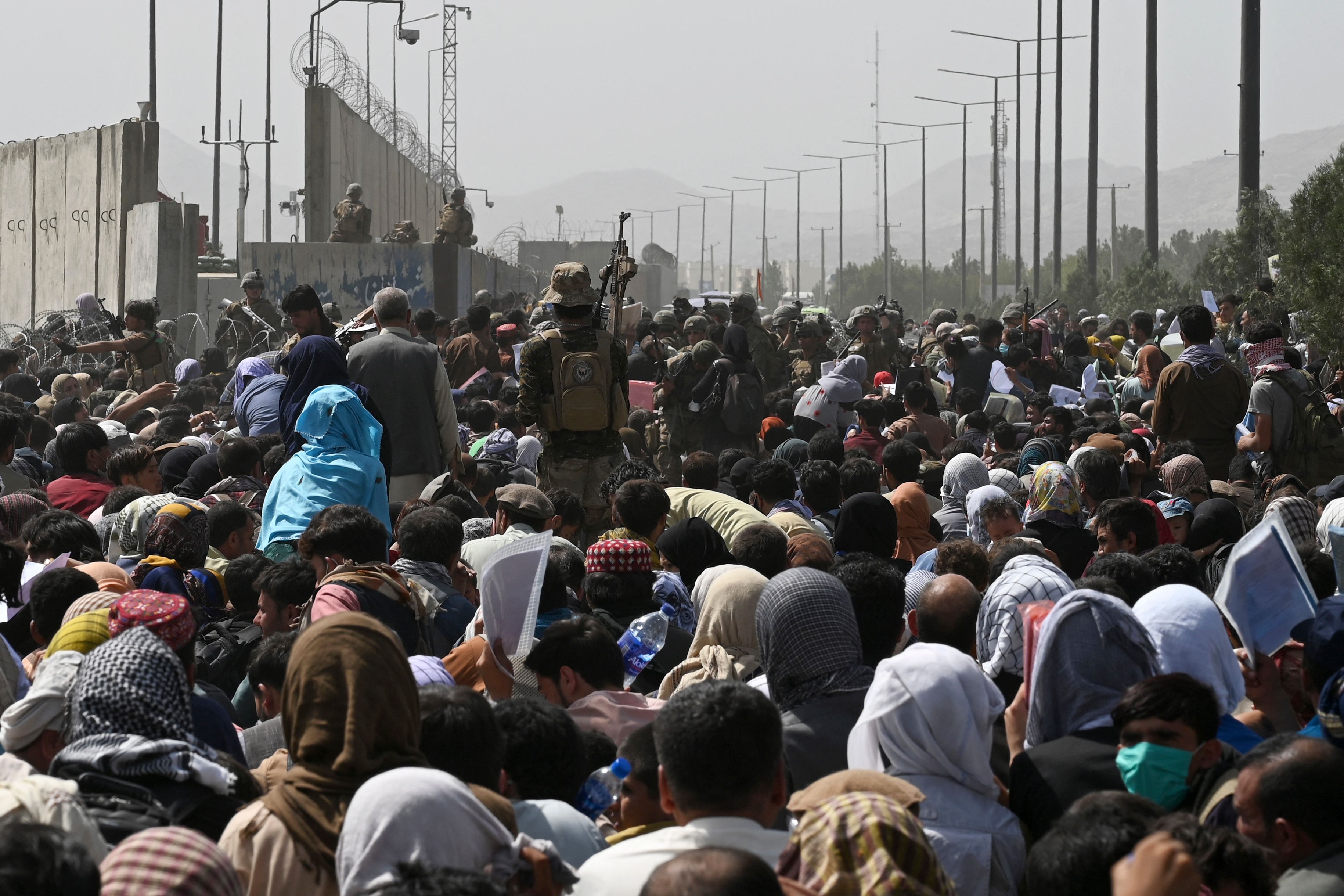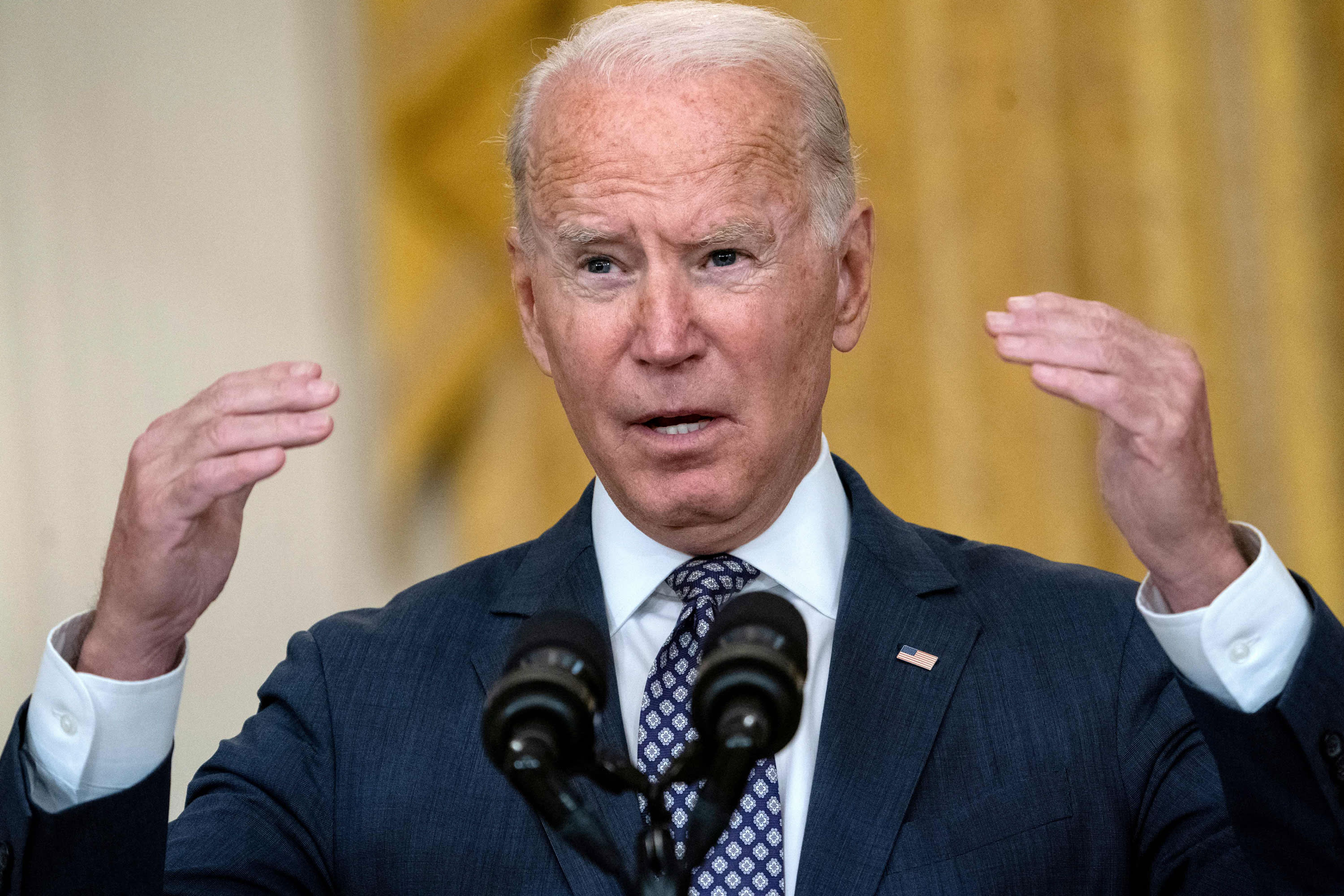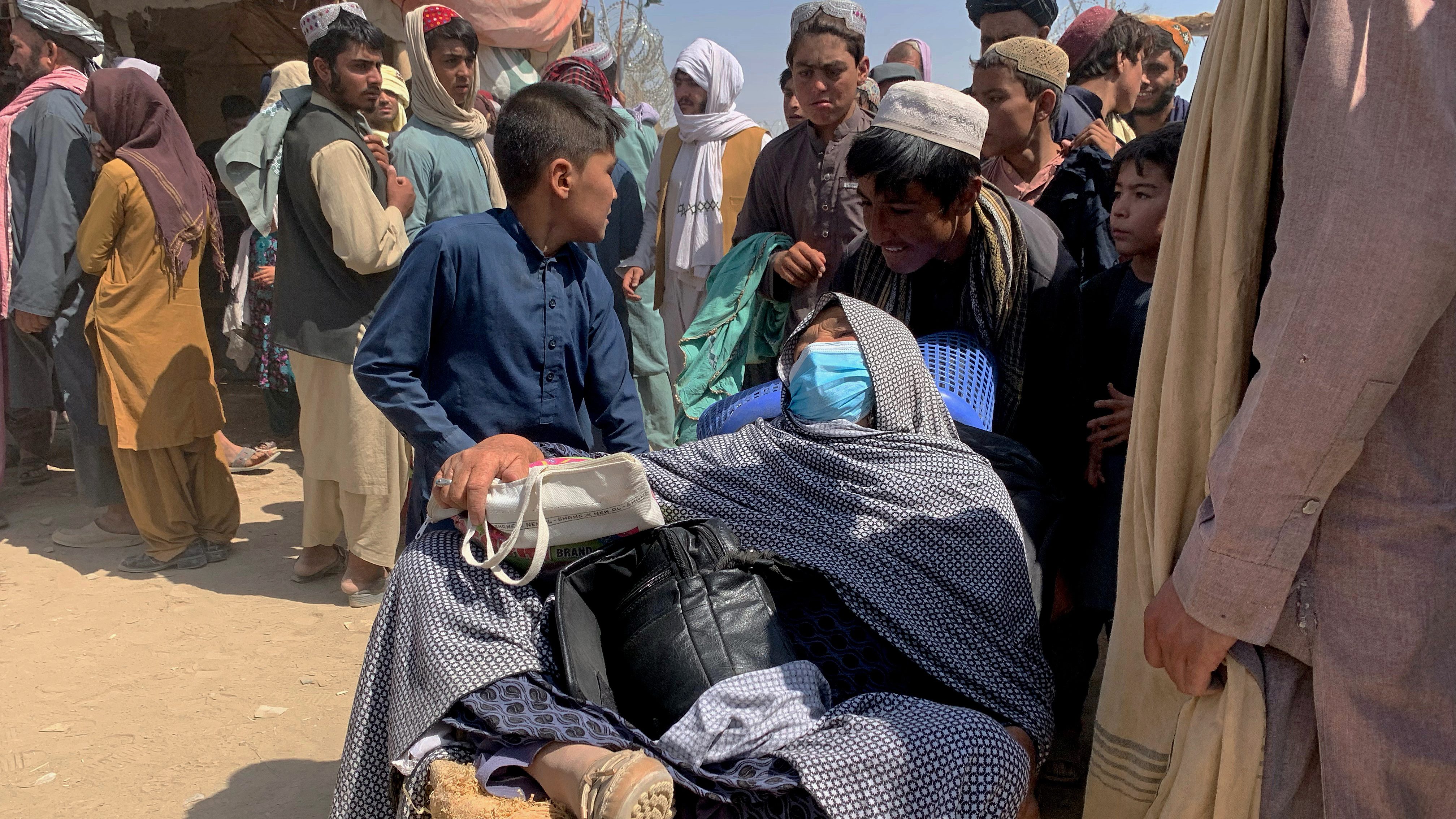The United States completed its withdrawal from Afghanistan on Monday, marking the end of a war that has cost tens of thousands of lives and trillions of dollars over the span of 20 years.
In the wake of U.S. forces departing, the Taliban seized control of the country and the Afghan government collapsed, sparking panic in Kabul and a rush to evacuate U.S. Embassy personnel, foreigners and Afghan allies.
The two-week airlift brought scenes of desperation and horror. Massive crowds of Afghan citizens desperate to flee the Taliban descended onto Kabul's main airport in the waning days of the U.S.-led evacuation campaign. American troops faced the daunting task of getting final evacuees onto planes while also getting themselves and some of their equipment out. Thirteen service members were killed in a suicide bombing at the airport on Aug. 26.
What happened and how did we get here?
Below is a timeline of events in Afghanistan that led to the Taliban's rise, fall and recapture of power after decades of war.
July 3, 1979 – U.S. Sets Up Proxy Against USSR
A covert CIA mission, named Operation Cyclone, funneled weapons and money to Pakistan's then-President Mohammed Zia-ul Hag as a proxy for the U.S. against the Soviet Union’s presence in Afghanistan. The operation cost more than $2 million over eight years, according to the New York Times.
Click here for a larger image.
December 25, 1979 – USSR Invades Afghanistan

Soviet Union troops invaded Afghanistan on Christmas as part of an alleged intervention in support of the Afghan communist government. The Soviets claimed that the new Afghanistan communist leader, Babrak Karmal, invited them into the country. The Soviet Union would remain for nearly a decade, until February 1989.
February 2, 1983 – Reagan Meets With Mujahadeen Fighters
On this day, President Ronald Reagan met with Afghan “freedom fighters” at the White House to discuss the violent acts carried out by the Soviet Union in Afghanistan. When the Soviets finally left, America was the next great power to step in.
September 26, 1986 – U.S. Supplies Region With Anti-Aircraft Stinger Missiles

Reaching a "stalemate" in combat, neither the U.S. nor Soviet Union gained advantage over the other at this point during the Afghanistan war. In response, President Ronald Reagan and White House officials turned to the stinger, a new, anti-aircraft, shoulder-launched heat-seeking missile, to target Soviet helicopters. The U.S. trained and equipped several Afghan rebels with stingers, who successfully shot down several choppers from the ground, securing the first major win for the U.S. against the air fleet.
February 15, 1989 – USSR Leaves Afghanistan
After 10 years in battle against the U.S.-backed mujahedeen, the Soviet Union negotiated its withdrawal from Afghanistan.

April 1992 – Pro-Soviet Government Collapses; Power Vacuum Sparks Civil War
The pro-Soviet Union government of Mohammad Najibullah collapses, making way for mujahedeen leaders to sweep in and take power. Najibullah is put under house arrest during this time.
In-fighting between mujahedeen groups would last for four years from 1992-1996, killing thousands of civilians, until the Taliban took over.
Early 1990s – Taliban Emerges in the Region
The Taliban emerged shortly after the Soviet’s withdrawal from Afghanistan. Mullah Omar founded the extremist Islamic group, whose primary goal was to enforce their strict interpretation of Sharia that includes public executions of convicted murderers and amputations for those found guilty of theft.
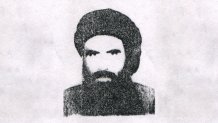
September 26, 1996 – Taliban Takes Control of Kabul
After barely putting up a fight, the Taliban swept across Afghanistan and took control of the capital city of Kabul.
President Najibullah was hanged by the insurgents one day after Kabul was taken over. In the years before his death, Najibullah had been forced from office and sought refuge in a United Nations compound, where was he sheltered for four years.
August 20, 1998 – Clinton Launches Air Strikes on Al-Qaeda Bases
After U.S. embassies in Nairobi and Dar es Salaam were attacked on Aug. 7, President Bill Clinton launched a set of air strikes targeted at several suspected Al-Qaeda bases in Afghanistan under "Operation Infinite Strike." The missiles hit their intended targets, but no terrorist leaders were killed.
March 2001 – Taliban Destroys Buddha Statues to Global Outcry

The Taliban demolished two massive Buddha statues from the 5th century that lined the Bamiyan Valley after declaring them to be a form of idolatry. The incident ignited global outcry and highlighted the struggle between the regime and persecuted minorities who lived in Afghanistan, such as the Shiite Muslims residing in Bamiyan.
September 11, 2001 – 9/11 Attacks
Nineteen terrorists hijacked four commercial airplanes to carry out attacks against the U.S. Two of the planes were flown into the upper floors of the Twin Towers at the World Trade Center in New York City, while another was flown into the Pentagon in Arlington, Virginia. The fourth plane crashed into an empty field outside of Washington, D.C. after passengers fought back against the hijackers.
The attack had been coordinated and backed by Osama bin Laden.
The Taliban was supporting Al-Qaeda in Afghanistan at the time of the attack that killed 2,977 people.


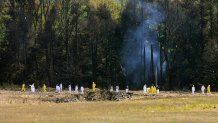
October 7, 2001 – U.S. Invades Afghanistan
In response to the 9/11 attacks, the U.S. launched "Operation Enduring Freedom" after the Taliban declined to extradite members of Al-Qaeda, sparking the war in Afghanistan.
Alongside the Northern Alliance, British and allied forces, the U.S. led a series of ground and air attacks with a stated mission to ensure that Afghanistan "is never again a sanctuary to al-Qaida or other transnational extremists that it was prior to 9/11."
November 13, 2001 – Taliban Flees Kabul Following U.S.-Led Airstrikes
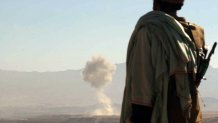
With the help of 90 countries supporting the United States, “Operation Enduring Freedom” led to the fall of Kabul on Nov. 13, 2001. After more than 217,000 troops from the coalition invaded Afghanistan and a total of 24,000 bombs were dropped, the Taliban fled Kabul and most of northern Afghanistan.
December 5, 2001 – Bonn Agreement
After the Taliban fled Kabul, Afghanistan was left without any form of law and order. Afghan officials met with the U.N. in Bonn, Germany, to create a plan to govern the country. The Bonn Agreement laid the foundation for the U.S. and NATO-backed efforts to begin rebuilding the country before a permanent government was established.
December 5, 2001 – Hamid Karzai Becomes President of Afghanistan
Afghan officials alongside the international community named Hamid Karzai chair of the interim administration over the country. In June 2002, a loya jirga -- a 'grand council' in the Pashto language -- named Karzai president of the transitional government.
December 7, 2001 – Taliban Regime Officially Collapses
Taliban forces surrendered their final grasp of control in the city of Kandahar, marking the official collapse of the Taliban regime.
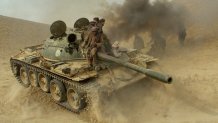
May 1, 2003 – Bush Prematurely Claims End of Wars in Iraq and Afghanistan
Standing under a “Mission Accomplished” banner, President George W. Bush claimed victory after declaring “major combat operations in Iraq have ended.” The speech was highly criticized because fighting persisted for several more years after the speech.
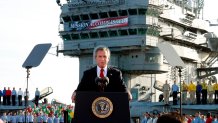
2006 – Taliban Reemerges, Begins to Reclaim Territories
With the U.S. busy in Iraq, Taliban forces grew stronger and gained momentum with a deadly wave of suicide attacks on NATO troops. The recuperating group of terrorists began reclaiming territory in parts of the South.
October 7, 2011 – Ten Year Anniversary of the 'War on Terror'
The United States marked ten years of occupation in Afghanistan by late 2011, surpassing the Soviet Union's occupation of nine years and 50 days.
December 8, 2014 – U.S., NATO Formally Ends Combat Mission
U.S. and NATO forces ended combat in Afghanistan and transitioned efforts to a support and training role. The Afghan army took over all military and security operations from NATO forces.
Meanwhile, President Barack Obama gave the green light for military operations against Taliban and al-Qaeda targets.
July 29, 2015 – Taliban Head Mullah Omar Confirmed Dead
The U.S. confirmed the death of Mullah Omar, the father of the Taliban. Despite the date of confirmation, Afghan officials said Omar had been dead for “a couple of years” by that time.
2015 to 2018
Taliban attacks against U.S. and Afghan forces increased to almost daily, as an Islamic State affiliate began to emerge. As tensions escalated, President Obama nixed his plans to withdraw troops from Afghanistan by the end of his time in office.
Attacks continued to increase as President Donald Trump entered office. Reneging on his past calls to exit Afghanistan, Trump unveiled his new strategy, saying the U.S. could not afford a hasty withdrawal from the country.
2018 to 2019
President Trump appointed Zalmay Khalilzad to negotiate with the Taliban as terrorist activity spiked in the region. The Taliban refused to negotiate with Kabul and more attacks continued to escalate.
August 18, 2019 – Suicide Attack Kills Dozens at Kabul Wedding

A suicide bomber detonated an explosives-filled vest in the middle of a wedding celebration, killing 63 people and injuring 182 others. The Islamic State claimed responsibility for the attack in Kabul. The continued activity of IS threatened Afghans citizens, leaving them to question their safety as the U.S. and Taliban negotiated a peace deal.
September 7, 2019 – Trump Attempts to Meet With Taliban Leadership
Taliban attacks continued to escalate rapidly throughout 2019. President Trump attempted to covertly meet with Taliban leadership on Sept. 8, 2019, four days before the 18th anniversary of the Sept. 11 attacks. The meeting was called off after a suicide attack killed a U.S. service member in Kabul.
February 29, 2020 – Trump Administration Brokers Deal to Withdraw Troops
The Trump Administration brokered a deal with the Taliban in early 2020 to withdraw U.S. troops from Afghanistan, in exchange for a promise from the Taliban to not use Afghanistan as a terrorist base. Troops would gradually withdraw over the course of 14 months under the agreement.

April 14, 2021 – Biden Announces Full Withdrawal of Troops
Officially setting an end to America’s longest war, President Joe Biden announced a full withdrawal of the country’s military presence in Afghanistan by Sept. 11, the 20th anniversary of the war. Biden said that the U.S. achieved the mission’s goal 10 years ago when Osama bin Laden was killed while hiding out in Pakistan.
May 1, 2021 – U.S., NATO Begins to Withdraw Troops
The U.S. and NATO enter the final phase of ending America’s longest war by beginning the withdrawal of their remaining troops – about 2,500-3,500 U.S. troops and about 7,000 NATO soldiers – in Afghanistan by Sept. 11.
April 2021 to August 2021 – Taliban Begins Massive Takeover of Afghanistan Districts
Taliban fighters seized power in Afghanistan, sweeping across the country and taking control of major cities and territories as Afghan officials conceded and U.S. allies evacuated.
July 2, 2021 – U.S. Relinquishes Control of Bagram Air Base
The U.S. handed over control of the Bagram Air Base to the Afghan military. The airfield served as the center for American forces in Afghanistan for two decades.
August 14, 2021 – Biden Sends Additional Troops to Help Evacuation and Withdrawal Efforts
To ensure an “orderly and safe drawdown,” President Biden authorized an additional 1,000 troops to help evacuate American and allied personnel from Afghanistan. The troops will also help pullout Afghans who worked with the military throughout the war.
August 16, 2021 – Kabul Falls to Taliban for a Second Time
Taliban militants overwhelm Afghanistan's cities within the matter of days. The Afghan government collapses, with the President of Afghanistan ceding power to the militants on August 16. Kabul International Airport became a scene of chaos as people become desperate to flee Taliban rule.
The Panjshir Valley becomes the sole area not under Taliban rule in Afghanistan. Opposition leaders were seen gathering there in videos, including a top official from the previous government and the son of a slain rebel leader.
Photos: A Timeline of US Involvement in Afghanistan
August 18, 2021 – Taliban Militants Violently End Afghan Protest
Taliban militants violently attacked a group of Afghan protesters, killing one during the clash, after the group lowered the regime’s flag in the eastern city of Jalalabad. The attack came as thousands of Afghans tried to flee after the Taliban’s swift takeover, giving what many feared to be a glimpse into the country's fate under Taliban rule.
August 26, 2021 – Suicide Bombers Kill 13 U.S. Troops in Afghanistan
Thirteen U.S. service members were killed outside of Kabul’s airport after suicide bombers and gunmen attacked crowds of Afghans desperately trying to flee. The blasts came hours after Western officials warned of a major attack, which also killed 169 Afghans.
President Joe Biden vowed to hunt down the attackers and make them pay. The Islamic State terror group claimed responsibility for the deadly attacks.
August 27, 2021 – U.S. Kills Two ‘ISIS-K Planners’ in Retaliatory Airstrike
The U.S. launched an airstrike against the IS, killing two “ISIS-K planners.” The attack came after what White House officials called indications of another attack in the waning days of the evacuation deadline.
August 30, 2021 – Rockets Target Kabul Airport on Eve of Evacuation Deadline
As many as five rockets were fired at Kabul’s airport just one day before the deadline expired for all U.S. troops to withdraw from Afghanistan. The missiles struck a nearby neighborhood and gunfire was heard afterward. ISIS-K also claimed responsibility for this attack.
August 31, 2021 – U.S. Completes Withdrawal, Ending 20-Year War in Afghanistan
The U.S. completed its full withdrawal of military troops from Afghanistan, marking the end to the country’s longest war with a rushed and chaotic exit. Taliban militants celebrated Afghanistan’s new “independence” with gunfire and fireworks as the last set of U.S. flights departed Kabul.
More News About Afghanistan
Additional reporting by the Associated Press. Editing by Kelly Whitney.

